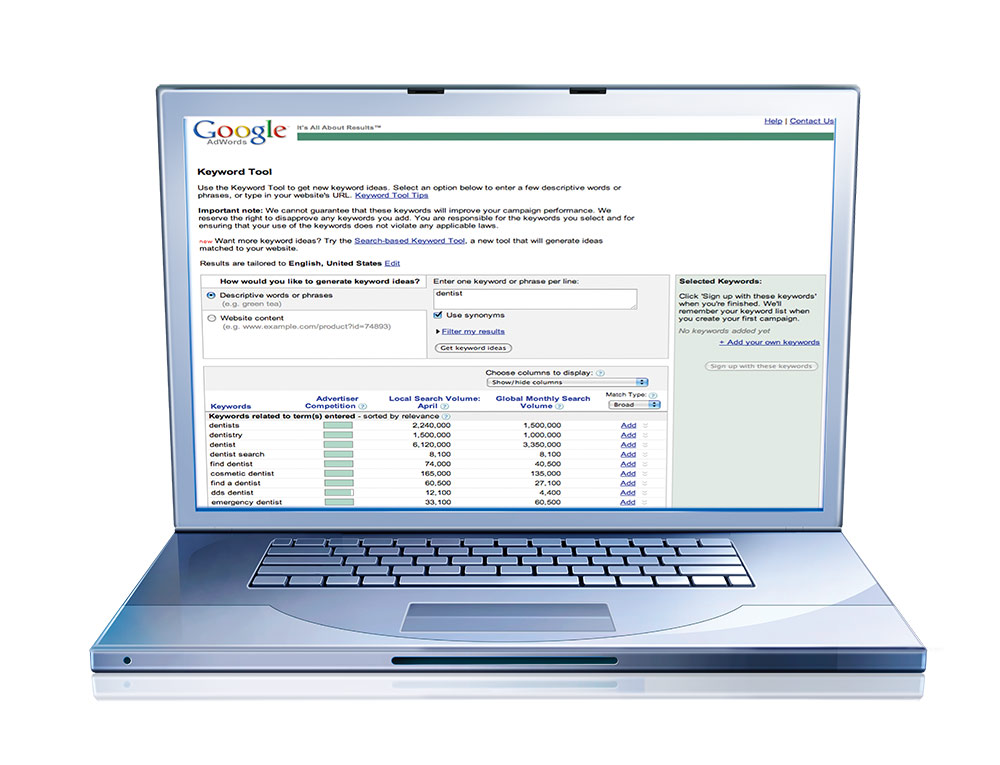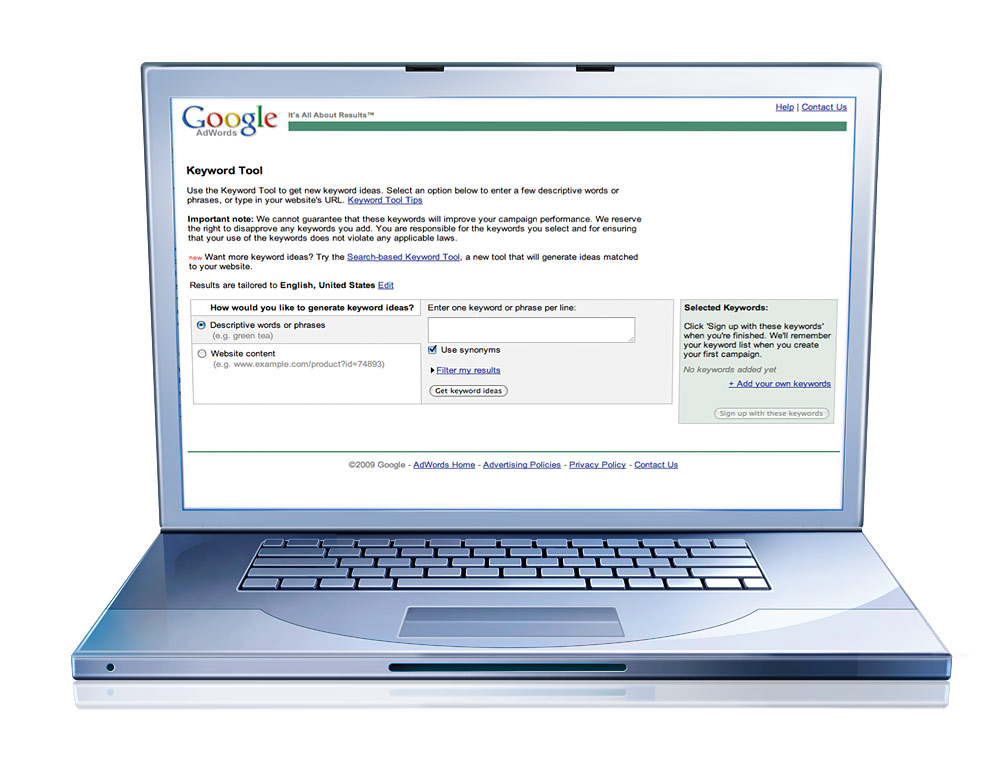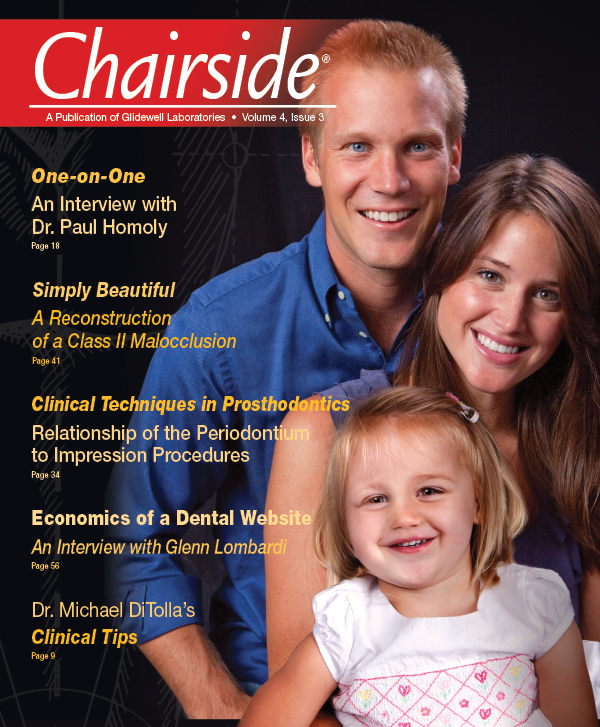The Economics of a Dental Website

In a down economy when most dentists are cutting back on their marketing budget, for less than a thousand dollars — a $100 or $200 a month budget — you can advertise specifically to people looking for dental services in your neighborhood.
Dr. Michael DiTolla: Glenn, we know that dentistry and the economy, as a whole, are currently seeing some challenging times. Dentistry, in general, is slowing down because dentists are prepping fewer crowns and bridges, and elective procedures have slowed down, too. So, I can understand a dentist thinking that this would be a good time to lower overhead. One of the first things that a dentist might cut is marketing, but I’m not sure that’s a great idea — unless you are considering a phone book ad, which might cost $8,000 to $10,000. Talk to me a little bit about the economics of a website and why, in trying economic times, a website is a worthwhile investment.
Glenn Lombardi: Well, like you said, when the economy slows down, and your practice starts to slow down, doctors look at their appointment books and begin to see openings. But that’s actually the time when they should beef up their marketing. Most dentists — when they are fully booked and everything’s going great and referrals are just walking in the door — don’t have the time to think about marketing. So, when things do slow down, it is actually the ideal time to pick up your marketing to potential patients in your area. If you look at all the options available to a dentist, from direct mail to advertising to the phone book, the dentist sits there and says: “OK, I have limited funds and I am in a down economy. What is going to have the highest probability of producing new patients? What is the best value available for my limited budget?” And that’s where a website can become very productive in two ways.
Number one, Officite offers a website package that gets dental practices online with an attractive, highly visible website for under $1,000. Number two, dentists can advertise their practice or for specific services in their local area through Google™ AdWords™ and Yahoo!® sponsored results programs, which are pay-per-click programs. That means you only pay for the patients who click on your ad and go directly to your website. In a down economy when most dentists are cutting back on their marketing budget, for less than a thousand dollars — a $100 or $200 a month budget — you can advertise specifically to people looking for dental services in your neighborhood.
MD: And with the Google AdWords, can you advertise for specific dental services? For example, if I provide snoring and sleep appliances, can I advertise specifically to those types of patients?
GL: Yes, that’s a great example. In that scenario, you want to attract a specific type of patient that you know is going to require a specific service offering that will generate a specific revenue flow for the practice. So, if a patient is having an issue with sleep apnea or snoring, the first thing they are going to do is Google “snoring” or “sleep apnea.” If you type “sleep apnea” into Google right now, on the left side and scrolling down you’re going to see results related to websites about sleep apnea information. But, if you look at the “Sponsored Links” at the top and on the right, there are numerous links highlighting messages such as “Stop Snoring Immediately! Sleep Apnea Treatment Available.” Here’s one that says, “LVI Dentist Offering Sleep Apnea Solution.”
This localized search marketing technology offers dentists a new opportunity to market specifically to patients who live or work in their practice area. Here’s how it works:
First, the dentist selects a radius around his or her office — a five-, 10- or 25-mile radius near their practice. Any time a person within this defined radius types in the words “sleep apnea” or “snoring,” your practice ad and link will pop-up on the top or right of the search results. Let’s say your ad reads: “Dentist Treating Sleep Apnea,” and contains copy specifically talking about the keyword that was entered by the consumer for the search. When patients outside your defined radius type in the same keywords, the search engine knows the location of the patient’s computer by their IP address, and thus shows your ad only to those patients inside your designated radius.
The power of this new search technology is at the exact moment when a prospective patient is looking for treatment related to sleep apnea or snoring, your ad and a direct link to your practice website is displayed. When the patient clicks on your ad, it takes them to a specific landing page on your website that talks about sleep apnea and educates the patient — all within one click from their original search results page. The page could describe the causes of sleep apnea, what possible solutions might be used, and what appliances are available. The key is to have a call to action or special offer that entices the patient to either call or email the office.
It’s not running an ad that goes to 40,000 people in your area looking for the 40 patients in need of a snoring device. It’s marketing specifically to the patient looking for a specific service at the exact moment they search. Plus, you can track every dollar spent to see what your return on investment is by keyword.
From this landing page, you will be able to track how many people email or call the office by using a “smart” phone number — which is a different phone number than your actual office phone number, but points to your office phone number so you can track and record each call. At Officite, we use this new technology and landing page process to track every click, dollar spent, email, phone call and new patient revenue associated with your ad. And because the dentist designates a monthly budget for terms such as “sleep apnea” and “snoring,” it’s easy to track their return on investment for every marketing dollar spent.
An example would be this: let’s say you get 50 clicks per month on your Google AdWords campaign. You can easily track which page each of the 50 patients visited, and then count how many take advantage of your offer and either email or call the office. From there, you can track how many patients schedule an appointment and the services rendered to each patient. What’s really powerful about the program is that it’s the only advertisement opportunity available that, at the exact moment a patient looks for a specific service in your practice area — such as sleep apnea or snoring — allows you to market your practice and drive patients directly to your website.

MD: That is pretty amazing because if I place a snoring or sleep apnea ad in Orange Coast magazine, one of the big magazines out here, and I spend a ton of money to put a full page ad in there, the people who are interested in sleep apnea may or may not ever see that ad in that magazine. In fact, the chances are probably pretty low that they do. But for a patient who doesn’t know much about sleep apnea, or any topic for that matter, dental or otherwise, they go to the internet — the encyclopedia has become a relic, a museum piece. You go to the internet to get information on the topics that you don’t know about. And it’s pretty amazing that right at that moment, when they enter a single word or phrase to learn more about sleep apnea, your name pops up right in front of them. And, as you mentioned, it’s local. I just typed in sleep apnea when you told me to, and it pulled up two doctors right here in Newport Beach.
GL: Exactly. Each dentist is going to get different results based on their location. And that’s based on the new local search capability that Google offers. The local dentist can now compete with the national companies for patients in their area. For patients who work or live in your area, you can now market specifically to them using exact terms, whether it be veneers, Invisalign® or snoring devices — whatever your practice specialty.
And it’s not a shotgun strategy either. That’s the beauty of this focused marketing solution. You’re not sending out 10,000 direct mail pieces and crossing your fingers that 30 people are looking for your services. It’s not running an ad that goes to 40,000 people in your area looking for the 40 patients in need of a snoring device. It’s marketing specifically to the patient looking for a specific service at the exact moment they search. Plus, you can track every dollar spent to see what your return on investment is by keyword.
MD: To be able to reach patients right at that moment when they have enough interest to sit down and search the web is really amazing. That’s got to be a marketing person’s dream. You mentioned veneers. For that example, I’m sure you can have “no-prep veneers” be your keywords. There are companies out there that will sign up for a steep monthly fee, which is much more expensive than what you’re talking about, to become one of their approved no-prep veneer doctors where you can get referrals from them. But instead you can use Officite and Google AdWords, set this up on your own, and have people who Google “no-prep veneers” be directed to your website.
GL: That’s a great example. Three to five years ago, the only available option to dentists for marketing their practices on the internet was to join one of these directory sites and be listed in your area with 10 other docs, or maybe a hundred dentists.
The good news is that times have changed, and Google has become the No. 1 directory on Earth. Now, you don’t have to join numerous directories and be listed with 10 other docs in your area. You can now be listed with your own ad and link to your website right in Google — and not in a directory. It’s a great way for you to market directly to the local patient searching for a specific service without paying a directory service to be listed with everybody else in your area.
MD: And as opposed to the “old school” Yellow Pages ad, where you listed every single thing that you did — extractions, crowns, bridges, veneers, all these things that the average patient may or may not be interested in — you now have the ability to advertise specifically for the procedures that the doctor likes to do. There are usually two or three, maybe four, procedures that the doctor really enjoys doing — the things that really make the practice fun and make it fulfilling to be a dentist. So, beyond just the production and collection of numbers that come from these procedures, this type of specific targeted marketing really stands to make dentists much happier in their own practice.
GL: Yes, that’s true. The key to this whole marketing process is that the website enables you to do 24/7 marketing. For example: it’s 2 a.m. and a spouse wakes up because his or her partner is snoring. The spouse goes online to find a solution for this problem. With a Google AdWords campaign, you now have an opportunity to market to them at 2 a.m. in the morning. Sure, your practice isn’t open at 2 a.m., but you are offering the patient the ability to learn about possible solutions for snoring on your website and to take action by emailing your practice directly. It is truly 24/7 marketing! Like you said, Dr. Michael, with an ad or a postcard there’s only so much you can tell them because of limited space. But with a website, you have the opportunity to expand on the topic and offer in-depth information about a specific service. You can show pictures of different appliances. If it’s a cosmetic procedure, you can display before and after photos. You have a much better chance at educating the patient right then, when they’re interested, which both attracts them to the practice and increases your case acceptance.
MD: I recently had to find a dermatologist for the first time in my life. I asked a couple friends for a recommendation, and one person liked their dermatologist but couldn’t remember the name. I did a Google search to find the person and I found that some of the dermatologists had websites and others didn’t. The one that I ended up going to had a website, had pictures of the doctors, included a picture of the staff — and I got the feeling by looking at their website that I kind of got to know who they were. I don’t know how much you can judge a business by pictures, but it made me feel more comfortable; and that’s the person that I ended up going to. Have you noticed those same kinds of things with respect to dental patients as they are looking to find a new dental office to go to, if they move to a new area, or something like that?
GL: Yes, you have a much higher probability just from a referral standpoint. While everybody recommends a dentist to a friend, the patient still may not be comfortable just going off of that referral. So, the website is there to further educate them, make them feel more comfortable, show them more pictures of the practice both outside and inside the office, tell them a little bit about yourself on the website — all of that helps the patient feel more comfortable. Let’s face it: You know there’s a reason a good percentage of the population doesn’t go to the dentist regularly. It’s the “fear factor.” Your website is only going to help them feel more comfortable and increase the odds that they’ll set up an appointment.

MD: Yes, that’s fantastic. I’m amazed that you can get this kind of presence on the internet so quickly. I mean, it sounds affordable at $995. How long is the turnaround time for someone to establish a presence on the internet?
GL: Well, it’s amazing. Our clients typically have their websites up within a day, if not hours. And that’s completely customized with all their information, logos, photos, everything uploaded and ready to go. Then to set up a Google AdWords campaign, a local search campaign like I talked about, also takes minutes. We can get a practice up and running within 30 to 45 minutes.
MD: That’s another huge advantage over an “old school” example, like the Yellow Pages ad. One of the things I love about the internet is that the next day, or a couple of days after this information gets submitted to Officite, you’re up on the internet. You have a site that’s just as legitimate and just as visible — maybe more so than somebody who’s had a website for five years.
GL: That’s right. And the beauty of Google AdWords and this pay-per-click strategy is that if you’re willing to spend more money than competitors in your area, you can be listed number one or two fairly quickly. The other nice thing is, unlike the Yellow Pages where you pay $8,000 and your ad starts in March and goes to the following February, with this pay-per-click strategy you can pause your campaign budget at anytime.
So, if you see great results spending $200 a month, you can increase it to $400 or $500. We have some doctors spending $2,000 a month on pay-per-click advertising because they are getting a high return with new patients. Some of our doctors get 80 or 90 new patients running their pay-per-click campaign, so it works. And if for some reason it’s not effective in your area, you can turn it off tomorrow. You’re not committed to some multi-thousand-dollar investment.
MD: Wow, that’s fantastic. Yes, with the Yellow Pages ad, you are doing it half a year ahead of time and you’re committing for the whole year. I mean, I’m 44 years old, so I’m neither young nor old, but I can’t even think of the last time I used the Yellow Pages. In fact, the environmental waste of delivering it to everybody’s front porch … I mean, maybe people still use it to order pizza, but I ordered Domino’s the other day on my TiVo (laughs). I don’t know if the Yellow Pages are even relevant for that anymore. I guess if your target market is patients 70 and older, the Yellow Pages might still be a good idea, but for everybody else …
GL: Anybody else … whenever I speak at events, that’s one of the questions I ask early in the presentation. I always ask, “Who remembers where their phonebook is at home?” Not many people raise their hands. We’ve gone from talking about how everybody is going to have a computer in their house to now — not only does everybody have two or three computers, but also they are online 24/7. That’s convenience; the world has changed since we moved from dial-up to broadband. You know, that was the big switch, when everybody switched from using AOL to using their local cable or Yahoo! or Gmail or whatever it is, to access the internet and their email. Everybody is online 24/7 now, so if you need something — if you want to know the weather or buy a camera — the first place you’re going is online. And then from there, you may still go out to shop for it. But everybody is using the internet as their No. 1 resource for looking things up.
MD: I just think it’s such a sophisticated way to market a dental practice because you can have a very classy-looking website. And let’s face it: not long ago, your only marketing choices were the Yellow Pages and the ValuPak (or whatever coupon book), where you’re going to be in there with the dry cleaner and the new Chinese restaurant (laughs). I mean, how classy was that? You can be a lot more elegant and sophisticated on a website, don’t you think?
GL: Agreed. You can have different photos, whether they are stock photos or photos of your patients, the imagery and colors, the logos — you can make it look much more professional than you can with just a regular ad. And you can separate yourself from the noise. That’s a great way to differentiate yourself, to brand your practice. If you have certain colors or a look and feel to your practice, you can incorporate that into your website. So again, the first time a patient goes to your website and sees a certain branding and feel and look, when they walk into your office and get that same feeling it only enhances that experience. Anything’s possible with the website.
MD: For those doctors whose practice is a little slow right now, they may think, “Well, it’s going to be too late for me to market.” That might be true with the old style of marketing. But if you’re slow right now in June and you want to be busier for July, it sounds like a website and Google AdWords campaign can be up and running in just a few days, which translates into literally getting new patients next week. Is that correct?
GL: That’s correct. It’s one of the few marketing vehicles available to a dentist that can be up and running within a few hours and, like you said, generate new patients for their practices by next month.

MD: Well, I’m a huge believer in the power of the internet. I’m a huge believer in the power of Officite, as I’ve seen with the traffic from my own website that I have with you guys. So I’m giving a big recommendation to the dentists out there. If they’ve tried to market their practice before with a marketing company or with the Yellow Pages or with coupons, or they’ve just avoided it completely because they didn’t think it was classy, it’s a different world today with the internet. I encourage every dentist to get in touch with Officite so that they have an opportunity to see that you can be professional online.
Even if a dentist is not going to go out and actively market, I think that if you don’t have a presence on the internet today it looks suspicious. If a prospective patient can’t even find a picture of what your practice looks like and what you and your staff look like, I find that to be somewhat skeptical. At least, it’s a sign that you’re probably not technologically relevant when it comes to … who knows what? Maybe even the equipment that you have in your office.
So, if dentists want to get in touch with you guys, Glenn, what’s the best way for them to do it?
GL: They can either call us at 888-748-2746 or go to our website, officite.com.
One last note for you: I’m just online looking this up, there’s a tool on Google to see how many times a word was typed into Google last month. And the word “dentist,” or other forms of it, was searched more than 10 million times in the month of April. And the words “sleep apnea” or “snoring” were also entered over a million times last month in Google.
MD: That’s in the U.S.?
GL: That’s in the U.S. And anybody can do that. Just go to Google and type in “keyword AdWords tool.” And you should get a link that says “Google AdWords: Keyword Tool.” Click on that, and then enter one keyword or phrase per line. Type “dentist.” Next you have to enter the security word. Then hit keyword ideas and it’ll give you a list.
MD: So, these are all different. I like the fact that 40,000 people entered “dental dentist.” I’m not even sure what they are going for there. “Best dentist” — 12,000 people.
GL: If you actually click on search volume by April, it recalculates it. Now scroll down the list and you’ll start to see a lot of towns in searches, like Chicago dentists and things like that. In fact, what town do you live in? Newport Beach? You can actually search your own town. Your terms won’t always appear, but most of the time it does. So, you can see which keyword terms are performing well and use those words to refine your campaign results.
MD: I like the fact that dentists can do this themselves, so they can see that we’re not lying (laughs). That’s perfect. We’ll do it a couple times this year and beat it in them. But anytime they can play around on the internet and see what we’re saying is true, I think it’s kind of neat that we can show them on a sidebar what to do. Thanks, Glenn!
To contact Officite, call 888-748-2746 or visit officite.com. Contact Glenn Lombardi at 800-908-2483 or glombardi@officite.com.
Google and AdWords are trademarks of Google, Inc. (Mountain View, Calif.).
Yahoo! is a registered trademark of Yahoo! Inc. (Sunnyvale, Calif.).
Officite is a registered trademark of Officite, LLC. (Downers Grove, Ill.).
Invisalign is a registered trademark of Align Technology, Inc. (Santa Clara, Calif.).




